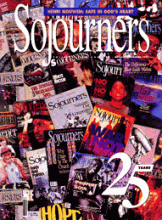FELLOW PSYCHOLOGY STUDENTS in Nijmegen in 1957 thought initially that newly ordained Henri Nouwen wanted to cultivate important people. “We misunderstood,” recalls one. “Henri was genuinely interested in people. We didn’t notice that he was as interested in the janitor or groundskeeper as he was in the important people we were watching.”
Nearly 40 years later, this was still recognizably Henri Nouwen: eager to cultivate people of all lands, to really know them, to help them take root and grow, to nurture and nourish anyone he met.
HENRI FIRST CAME to the United States as a ship’s chaplain in his 20s, and gradually became a well-known spiritual author, teacher, and speaker. He was a hugely popular professor at Notre Dame, Yale, and Harvard, traveling widely, his influence extending to people of many faiths. He was never a cloistered academic.
Even so, it was remarkably courageous 10 years ago when Henri moved to L’Arche Daybreak in Richmond Hill, Ontario. Many members of L’Arche do not read, so Henri was choosing to live where his reputation meant nothing. His restless soul longed for a home where people would be less interested in his credentials than in who he was.
He found it: Everyone at Daybreak was interested in a 55-year-old priest of such brilliance who seemed unable to make a sandwich; who totaled a new car driving it away from the dealership; who spoke with his giant hands flailing and his whole gangly body quivering with his desire to communicate; whose Dutch accent could offer a whole meditation on “face” and only halfway in would we catch on that he was speaking of faith ; who might in a single week be giving talks on three continents; whose friends came hitch-hiking and in private planes; who loved to dance with the community’s children at liturgies; who willingly shared in his 30-some books details of his inner life that most of us would cringe to admit, much less publish! Daybreak met a deep need in the heart of someone very gifted and very broken, wonderful in his capacity for friendship and insatiable in his need for friendship.
Just as Daybreak loved Henri, he grew to love Daybreak. He developed a deep friendship with Adam Arnett (1961-1996), a man who never spoke a word. Henri describes that relationship in his forthcoming book, Adam (Orbis Books). Henri continued to accept speaking engagements, but rarely traveled without members of the community to speak with him. “People won’t remember a word I said,” he reflected, “but they’ll remember that Bill Van Buren and I stood here as friends and equals and spoke together.”
Once an audience of several thousand people was hanging silently on to his every word. As he reached the climax of his insights, Bill leaned over and spoke into the microphone: “I’ve heard that before.” It totally exploded the suspense. Henri loved to tell that story.
Read the Full Article

